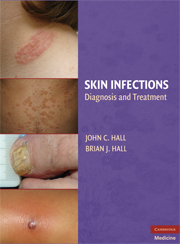Book contents
- Frontmatter
- Contents
- List of Contributors
- Acknowledgments
- INTRODUCTION
- TECHNIQUES IN DIAGNOSING DERMATOLOGIC MANIFESTATIONS OF INFECTIOUS DISEASES
- PRINCIPLES OF MANAGEMENT OF DERMATOLOGIC INFECTIONS IN THE SKIN
- PART 1 COMMON INFECTIONS
- PART II LESS COMMON INFECTIONS
- 4 CUTANEOUS TUBERCULOSIS
- 5 LEPROSY
- 6 ATYPICAL MYCOBACTERIA
- 7 ARTHROPOD-BORNE INFECTION
- 8 DEEP FUNGAL INFECTIONS
- 9 PARASITOLOGY
- PART III INFECTIONS IN SELECTED ECOSYSTEMS
- PART IV INFECTIONS IN SELECTED PATIENT POPULATIONS
- PART V INFECTIONS OF SPECIFIC SKIN-ASSOCIATED BODY SITES
- PART VI SPECIAL DISEASE CATEGORIES
- Index
9 - PARASITOLOGY
from PART II - LESS COMMON INFECTIONS
Published online by Cambridge University Press: 08 January 2010
- Frontmatter
- Contents
- List of Contributors
- Acknowledgments
- INTRODUCTION
- TECHNIQUES IN DIAGNOSING DERMATOLOGIC MANIFESTATIONS OF INFECTIOUS DISEASES
- PRINCIPLES OF MANAGEMENT OF DERMATOLOGIC INFECTIONS IN THE SKIN
- PART 1 COMMON INFECTIONS
- PART II LESS COMMON INFECTIONS
- 4 CUTANEOUS TUBERCULOSIS
- 5 LEPROSY
- 6 ATYPICAL MYCOBACTERIA
- 7 ARTHROPOD-BORNE INFECTION
- 8 DEEP FUNGAL INFECTIONS
- 9 PARASITOLOGY
- PART III INFECTIONS IN SELECTED ECOSYSTEMS
- PART IV INFECTIONS IN SELECTED PATIENT POPULATIONS
- PART V INFECTIONS OF SPECIFIC SKIN-ASSOCIATED BODY SITES
- PART VI SPECIAL DISEASE CATEGORIES
- Index
Summary
This chapter will cover most of the organisms that directly or indirectly compromise tissues through human infection. Although in developed countries they are considered exotic diseases just to be diagnosed in travelers, many of them represent a major health problem for developing countries around the world.
HISTORY
Parasites have accompanied mankind since antiquity. Dracunculiasis is described in the Ebers papyrus from 1500 BC, and references to this disease are clearly identified in the Bible. The ancient symbol of medicine, the staff of Asklepios, is believed by some scholars to also represent the treatment of dracunculaisis which involves slowly extracting the worm by winding it around a stick. This treatment is still in use to this day. Tenias were described by the ancient Greeks and are cited by Aristotle in his History of Animals.
Protozoa have ancient history in human disease annals. Evidence of Trypanosoma cruzi DNA has been found in mummies from Peru and northern Chile dating from 2000 BC to AD 1400. Old world cutaneous leishmaniasis is described on tablets in the library of King Ashurbanipal from the 7th century BC. The famous Arab physician Avicenna already described oriental sore in the 10th century as Balkh sore. New world leishmaniasis, as mucocutaneous disease, is clearly represented in ancient Peruvian pottery from the 5th century. The separation of Old World and New World Leishmanisis was a contribution of Gaspar Vianna, who in 1911 created a new species, Leishmania braziliensis.
- Type
- Chapter
- Information
- Skin InfectionsDiagnosis and Treatment, pp. 117 - 132Publisher: Cambridge University PressPrint publication year: 2009



